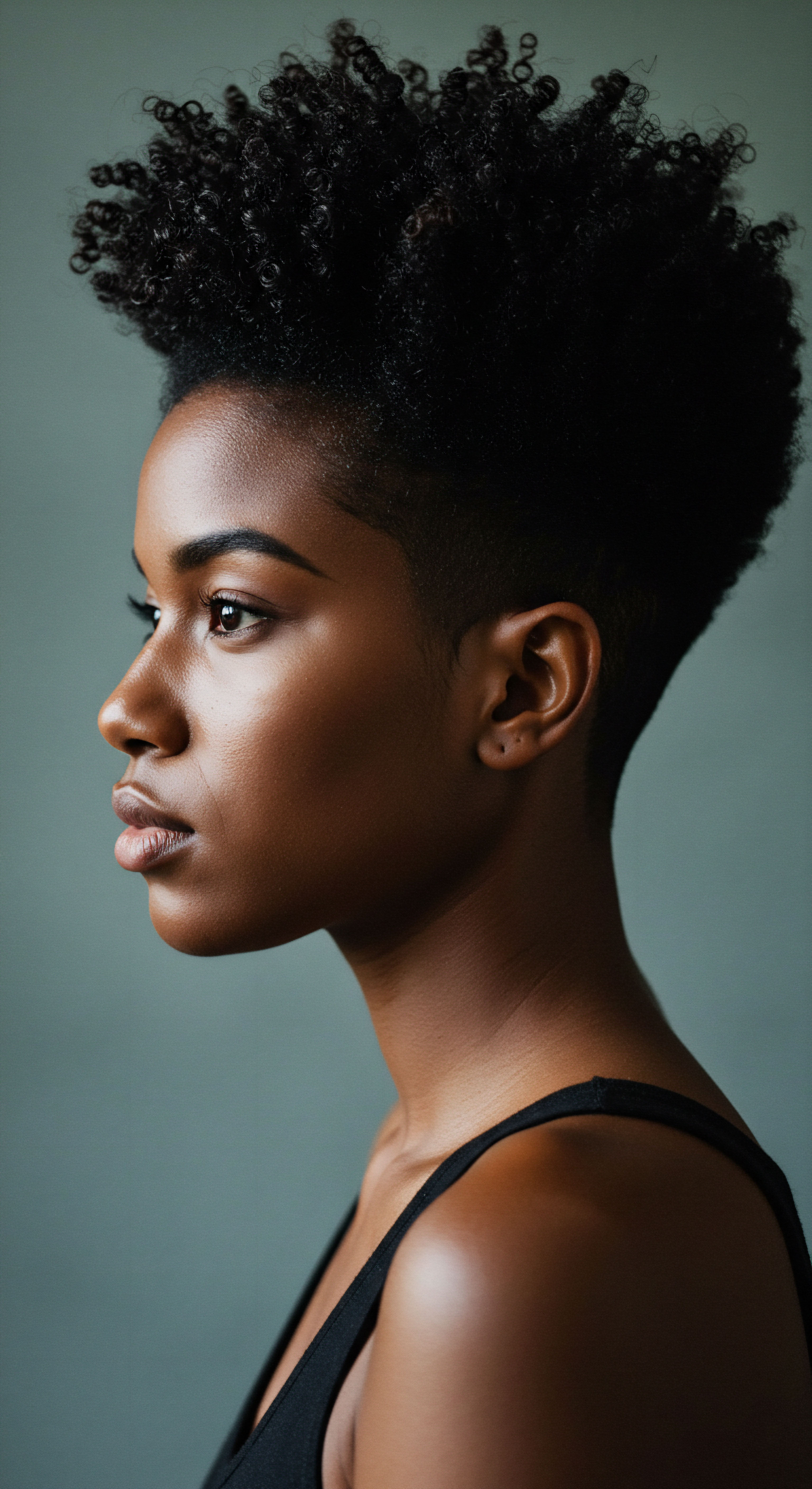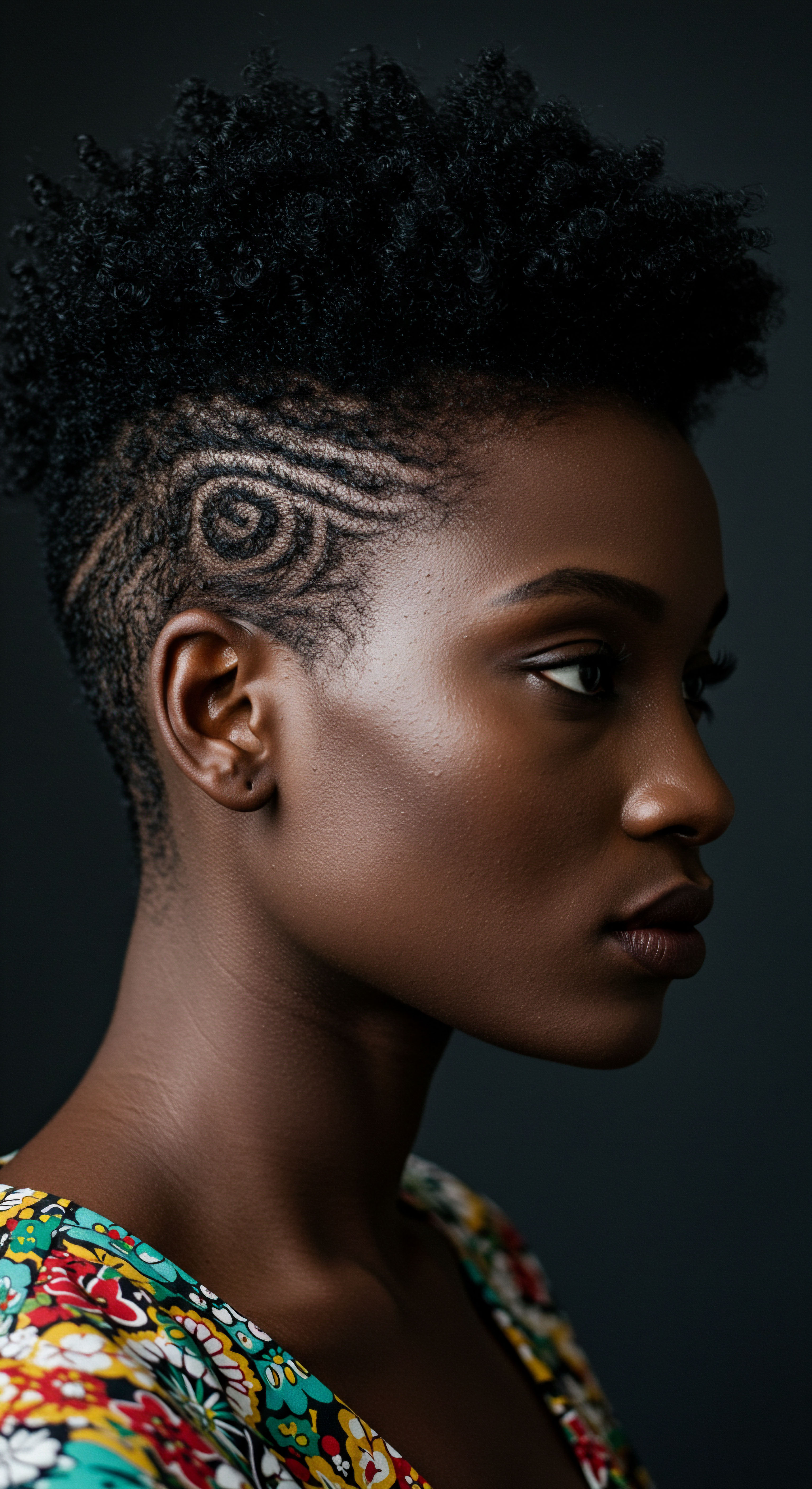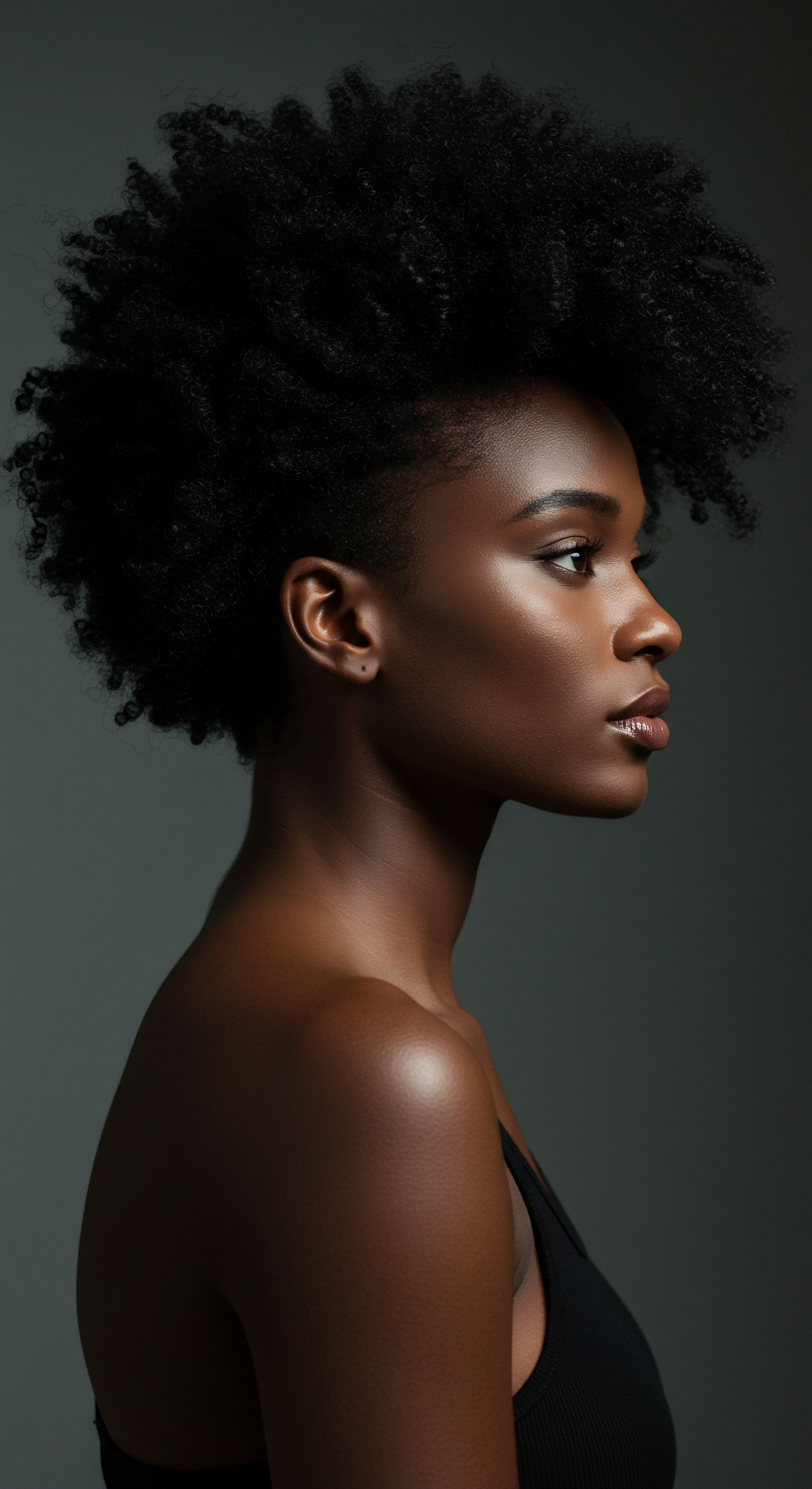
Roots
The silent whispers of the Nile’s sands often speak of grandeur and gold, yet a deeper listening reveals tales spun not of precious metals, but of something far more intimate ❉ the strands adorning ancient Egyptian heads. These weren’t merely coverings; they were vibrant proclamations, a language understood across the societal spectrum, conveying messages beyond mere affluence. To truly grasp the world of the pharaohs and their people, one must peer past the gleaming sarcophagi and instead observe the carefully coiffed, the intricately braided, the artfully arranged hair that adorned men, women, and children alike.
Consider the fundamental connection to one’s self, to one’s lineage, held within the very structure of hair. In ancient Egypt, this connection extended outward, becoming a visual marker of belonging, a testament to one’s place within a meticulously ordered universe. The choice of a particular style, the maintenance it required, the very materials used in its adornment—each element carried weight, contributing to a lexicon of personal and collective identity.
Ancient Egyptian hairstyles served as a visual language, communicating complex messages about identity and societal standing beyond simple economic means.

The Living Crown and Its Cultural Weight
The Egyptians held hair in considerable esteem, perceiving it as a living extension of the individual, imbued with protective and even spiritual qualities. This reverence shaped their approach to its care and styling. Unlike some cultures where hair might be concealed, in Egypt, it was often celebrated, styled with remarkable artistry, and frequently augmented with wigs or extensions. The meticulous attention given to hair, from the earliest dynasties, speaks to its profound cultural weight.
The dry desert climate and the prevalence of head lice meant that hygiene played a considerable role in hair practices. Shaving the head, for instance, was a practical measure, particularly for priests and those in specific religious roles, signifying purity and devotion. Yet, even a shaved head was not a blank slate; it became a canvas for carefully crafted wigs, each with its own set of symbolic associations. The underlying principle remained ❉ whether natural or artificial, hair was a medium for expression and societal placement.

The Semiotics of Strands
The visual cues offered by ancient Egyptian hair were akin to a complex semiotic system, where specific styles, lengths, and adornments acted as symbols. These symbols were widely understood, allowing individuals to signal their social standing, their profession, their age, and even their marital status. For instance, the sidelock of youth, a distinctive braid worn by children, clearly marked them as not yet adults, irrespective of their family’s wealth. This universal sign transcended economic divisions, placing every child within a recognized developmental stage.
The quality of a wig, certainly, could indicate wealth, with finer human hair being more expensive than plant fibers. Yet, the style itself, the particular cut or arrangement, often carried meaning that was accessible to all who understood the visual language. A simple, practical cut for a laborer, for example, might signify their dedication to their work, a valued trait, rather than a lack of resources.
- Sidelock of Youth ❉ A specific braid worn by children, denoting their age and unmarried status.
- Wig Quality ❉ While a marker of wealth, the style itself conveyed more than just material prosperity.
- Hair as Identity ❉ Beyond personal adornment, hair was a powerful tool for social communication.

Ritual
As we step from the foundational understandings of ancient Egyptian hair into the realm of its practical application, we uncover a world where daily rituals and specific styling techniques were not merely about appearance, but about a deep connection to well-being, societal expectations, and even the divine. The meticulous care, the crafting of wigs, and the choice of adornments speak to a practical wisdom, a daily engagement with hair that extended far beyond simple aesthetics. This is where the strands truly begin to tell their stories, where personal choices intersected with collective understanding.
The very act of preparing one’s hair or wig was a ritual in itself, often involving a suite of specialized tools and unguents. These practices, passed down through generations, solidified hair’s role as a canvas for both individual expression and a reflection of communal values. The effort invested in these routines underscores their significance, transforming what might seem like mundane tasks into meaningful gestures.

The Artistry of Ancient Egyptian Hair Care
Ancient Egyptians were pioneers in hair care, developing sophisticated products and techniques. Ointments made from animal fats, beeswax, and plant extracts were common, serving as conditioners, styling aids, and even sunscreens. Combs fashioned from wood or bone, razors of bronze or flint, and curling irons heated over fires were all part of their grooming arsenal. These tools allowed for remarkable precision and variety in styling.
The creation of wigs, in particular, was a highly skilled craft. Wigs were constructed from human hair, plant fibers, or even wool, meticulously braided or woven onto a mesh base. They offered versatility, protection from the sun, and a hygienic alternative to natural hair. The choice to wear a wig, and the style of that wig, often communicated as much as, if not more than, one’s natural hair.
Ancient Egyptian hair practices, from daily grooming to wig creation, were sophisticated rituals reflecting both personal care and societal expectations.

How Did Specific Styles Communicate Status Without Gold?
While the materials used in wigs could signify wealth, the specific styles themselves conveyed nuanced messages that transcended mere economic standing. Consider the famous “tripartite” wig, often seen on depictions of royalty and high officials. Its voluminous form and precise layering spoke of order, stability, and a connection to the established hierarchy. Yet, variations of this style, perhaps less elaborate or made from less costly materials, could be adopted by individuals seeking to align themselves with the aesthetics of power, expressing aspiration or a shared cultural ideal rather than simply displaying riches.
For the common people, simpler, more practical styles prevailed. Braids were common, offering a durable and manageable option for those engaged in physical labor. These styles, while perhaps less ostentatious, were not without their own significance.
They communicated diligence, a grounded existence, and an adherence to the practical realities of daily life. The cleanliness and neatness of such styles, even if simple, were indicators of self-respect and social conformity, valued traits across all societal levels.
A striking example of hair communicating beyond wealth comes from archaeological findings. A study of hair samples from individuals buried in ancient Egyptian tombs, including those of lower social standing, revealed the widespread presence of specific hair dyes, notably henna. While the quality of wigs might vary, the application of henna for color or conditioning was accessible and practiced across different economic strata.
This points to a shared aesthetic desire for vibrant, healthy-looking hair, a form of personal expression that was not exclusive to the elite. The widespread use of henna, as evidenced in mummified remains, indicates a common cultural value placed on hair’s appearance, regardless of one’s economic standing.
| Adornment Type Gold Bands |
| Common Usage Royalty, High Officials |
| Meaning Beyond Wealth Divine connection, established authority, permanence |
| Adornment Type Linen Ribbons |
| Common Usage All social classes |
| Meaning Beyond Wealth Neatness, adherence to social norms, personal tidiness |
| Adornment Type Floral Garlands |
| Common Usage Festivals, Celebrations |
| Meaning Beyond Wealth Joy, connection to nature, communal participation |
| Adornment Type Beads (Clay/Faience) |
| Common Usage Various classes |
| Meaning Beyond Wealth Personal expression, protective symbolism, cultural affiliation |
| Adornment Type These elements show how materials and styles conveyed messages beyond economic status. |

Relay
Moving into the deepest currents of ancient Egyptian hair’s significance, we encounter a sophisticated interplay of biological realities, psychological aspirations, and cultural directives. How did the very strands of hair, or their carefully crafted substitutes, become conduits for profound social narratives and individual declarations that transcended the simple ledger of possessions? This inquiry requires us to dissect the complex layers of meaning embedded within each braid, each wig, each shaved scalp, recognizing hair not as a static ornament, but as a dynamic participant in the human experience.
The choices made about hair were never isolated acts of vanity; they were deeply interconnected with a broader understanding of self and society. This section will explore the subtle yet potent ways hair communicated not just status, but also values, beliefs, and even resistance, offering a profound understanding of ancient Egyptian identity.

Hair as a Symbol of Life and Death
The Egyptians’ preoccupation with the afterlife meant that every aspect of earthly existence was considered in relation to eternity. Hair, as a part of the living body, held particular significance. It was carefully preserved, sometimes even after death, reflecting a belief in the continuation of the individual’s essence.
Hair offerings, found in tombs, suggest a ritualistic importance, a desire to carry aspects of one’s identity into the next realm. This profound connection to mortality and immortality imbued hair with a spiritual dimension that went far beyond its aesthetic qualities.
The meticulous care of hair in life, therefore, was not merely for earthly presentation; it was also a preparation for the journey beyond. The health and vitality of one’s hair could be seen as a reflection of one’s overall well-being, a desirable state for both the living and the deceased.

Did Hair Ever Challenge Social Norms?
While much of ancient Egyptian society emphasized conformity and order, instances of individual expression, sometimes subtly challenging established norms, can be discerned through hair. Consider the hairstyles of dancers or musicians, often depicted with wilder, more unbound styles compared to the rigid formality of the elite. These styles, while still within accepted parameters, suggested a freedom of movement and spirit, a deviation from the strictures of formal court life. This was not a direct defiance of wealth-based hierarchy, but rather an expression of a different kind of value—artistic freedom or a connection to a less formal, more visceral realm of human experience.
Even within the confines of societal expectations, personal choice played a role. The selection of specific hair ornaments, for instance, even simple beads or ribbons, allowed for individual taste to shine through. While the materials might be humble, the arrangement or the chosen color could communicate a unique personality. This micro-level expression, often overlooked, reveals a persistent human desire for individual identity, even within a highly structured society.
Beyond status, ancient Egyptian hair conveyed deeper meanings of vitality, spiritual connection, and subtle personal expression within societal boundaries.
One intriguing aspect that suggests hair could signal more than wealth is the practice of shaving the head, particularly for women, not for religious reasons, but potentially due to health issues or even as a form of mourning. While wigs were commonly worn over shaved heads, the initial act of shaving, and the subsequent choice of wig, could signify a temporary vulnerability or a transition in life circumstances. This practice, often accompanied by specific wig styles for mourning, indicates a system where hair could communicate a personal state, a shared human experience of loss or ailment, that transcended one’s material standing. The “hair of the deceased” found in some tombs, carefully preserved and often braided, further points to hair as a marker of identity that endured beyond life itself, regardless of the individual’s societal position.
- Stylistic Adaptations ❉ How common styles were adapted by different social strata.
- Ritualistic Significance ❉ The role of hair in religious ceremonies and funerary practices.
- Personal Embellishments ❉ The use of specific adornments to express individual taste.
| Hair State/Style Sidelock of Youth |
| Potential Meaning Childhood, pre-adulthood |
| Societal Layer Universal across all families |
| Hair State/Style Shaved Head (for women) |
| Potential Meaning Mourning, illness, ritual purity |
| Societal Layer Accessible experience across classes |
| Hair State/Style Simple Braids |
| Potential Meaning Practicality, labor, groundedness |
| Societal Layer Common for working individuals |
| Hair State/Style Elaborate Wigs |
| Potential Meaning Formal occasions, high status |
| Societal Layer Aspiration, social climbing, established power |
| Hair State/Style These examples highlight hair's capacity to convey messages beyond simple economic standing. |

Reflection
The enduring legacy of ancient Egyptian hair practices reminds us that our relationship with our strands has always been deeply personal, yet inextricably linked to the world around us. From the protective sidelocks of childhood to the elaborate wigs of ceremony, hair was a silent yet eloquent storyteller, communicating tales of belonging, aspiration, and even the quiet dignity of daily life. It was a language spoken not just by pharaohs and priests, but by every individual who cared for their crown, whether natural or crafted, making it a powerful testament to the enduring human spirit of self-expression and connection.

References
- 1. Lucas, Alfred. Ancient Egyptian Materials and Industries. Edward Arnold, 1962.
- 2. Fletcher, Joann. The Search for Nefertiti ❉ The True Story of an Amazing Archaeological Discovery. William Morrow, 2010.
- 3. Robins, Gay. The Art of Ancient Egypt. Harvard University Press, 1997.
- 4. Teeter, Emily. Religion and Ritual in Ancient Egypt. Cambridge University Press, 2011.
- 5. Stevens, Anna. Private Religion at Amarna ❉ The Material Evidence. Archaeopress, 2006.
- 6. Tyldesley, Joyce. Egypt ❉ From the Pharaohs to the Fall of Rome. Routledge, 2011.
- 7. Bard, Kathryn A. An Introduction to the Archaeology of Ancient Egypt. Blackwell Publishing, 2008.
- 8. Ikram, Salima. Death and Burial in Ancient Egypt. Longman, 2003.